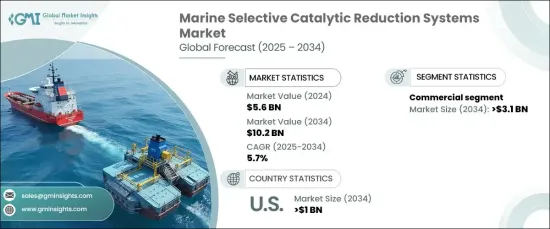PUBLISHER: Global Market Insights Inc. | PRODUCT CODE: 1667159

PUBLISHER: Global Market Insights Inc. | PRODUCT CODE: 1667159
Marine Selective Catalytic Reduction Systems Market Opportunity, Growth Drivers, Industry Trend Analysis, and Forecast 2025 - 2034
The Global Marine Selective Catalytic Reduction Systems Market was valued at USD 5.6 billion in 2024 and is projected to expand at a CAGR of 5.7% from 2025 to 2034. These advanced emission control technologies are designed to reduce nitrogen oxides in marine engine exhaust gases. SCR systems work by using a catalytic converter and a urea-based reagent, triggering a chemical reaction that converts harmful NOx into harmless nitrogen and water vapor. These systems play a crucial role in helping marine operators comply with strict environmental regulations, including the International Maritime Organization's Tier III standards, minimizing the ecological impact of maritime activities.

The growing emphasis on adhering to both global and regional environmental standards is expected to accelerate the adoption of marine SCR systems. As regulations tighten, these systems offer an effective solution for reducing emissions in line with international maritime laws. In addition, the ability of SCR systems to mitigate the environmental footprint of marine operations further boosts their adoption, especially considering rising global concerns over pollution and climate change.
| Market Scope | |
|---|---|
| Start Year | 2024 |
| Forecast Year | 2025-2034 |
| Start Value | $5.6 Billion |
| Forecast Value | $10.2 Billion |
| CAGR | 5.7% |
The commercial application segment of the marine SCR systems market is anticipated to reach USD 3.1 billion by 2034. The growth of international trade and the dominance of commercial vessels are expected to drive increased demand for SCR systems. Shipping companies are becoming more focused on adopting sustainable practices, and as environmental awareness among stakeholders increases, the pressure to meet regulatory standards will grow. Additionally, as key shipping hubs enforce local NOx emission control standards alongside international regulations, commercial vessel operators will be compelled to install SCR systems to ensure compliance.
U.S. marine selective catalytic reduction systems market is projected to reach USD 1 billion by 2034. Stringent regulations aimed at reducing emissions, combined with the push to modernize aging fleets, are expected to drive the demand for advanced emission control technologies. As emission standards become more rigid, the need for efficient SCR systems will intensify, especially with the increasing number of shipbuilding projects worldwide. These factors collectively highlight the critical role of SCR systems in achieving emission compliance and improving the environmental sustainability of the marine industry.
Table of Contents
Chapter 1 Methodology & Scope
- 1.1 Research design
- 1.2 Base estimates & calculations
- 1.3 Forecast model
- 1.4 Primary research & validation
- 1.4.1 Primary sources
- 1.4.2 Data mining sources
- 1.5 Market Definitions
Chapter 2 Executive Summary
- 2.1 Industry synopsis, 2021 – 2034
Chapter 3 Industry Insights
- 3.1 Industry ecosystem
- 3.2 Regulatory landscape
- 3.3 Industry impact forces
- 3.3.1 Growth drivers
- 3.3.2 Industry pitfalls & challenges
- 3.4 Growth potential analysis
- 3.5 Porter's analysis
- 3.5.1 Bargaining power of suppliers
- 3.5.2 Bargaining power of buyers
- 3.5.3 Threat of new entrants
- 3.5.4 Threat of substitutes
- 3.6 PESTEL analysis
Chapter 4 Competitive landscape, 2024
- 4.1 Introduction
- 4.2 Strategic dashboard
- 4.3 Innovation & technology landscape
Chapter 5 Market Size and Forecast, By Application, 2021 – 2034 (USD Billion & Units)
- 5.1 Key trends
- 5.2 Commercial
- 5.2.1 Container vessels
- 5.2.2 Tankers
- 5.2.3 Bulk carriers
- 5.2.4 Roll On/Roll off
- 5.2.5 Others
- 5.3 Offshore
- 5.3.1 PSV
- 5.3.2 FSV
- 5.3.3 MPSV
- 5.3.4 Others
- 5.4 Recreational
- 5.4.1 Cruise ships
- 5.4.2 Ferries
- 5.4.3 Yachts
- 5.4.4 Others
- 5.5 Navy
- 5.6 Others
Chapter 6 Market Size and Forecast, By Region, 2021 – 2034 (USD Billion & Units)
- 6.1 Key trends
- 6.2 North America
- 6.2.1 U.S.
- 6.2.2 Canada
- 6.3 Europe
- 6.3.1 Germany
- 6.3.2 UK
- 6.3.3 Italy
- 6.3.4 Norway
- 6.3.5 France
- 6.3.6 Russia
- 6.3.7 Denmark
- 6.4 Asia Pacific
- 6.4.1 China
- 6.4.2 Japan
- 6.4.3 India
- 6.4.4 South Korea
- 6.4.5 Australia
- 6.4.6 Vietnam
- 6.5 Middle East & Africa
- 6.5.1 Saudi Arabia
- 6.5.2 UAE
- 6.5.3 South Africa
- 6.5.4 Angola
- 6.6 Latin America
- 6.6.1 Brazil
- 6.6.2 Argentina
- 6.6.3 Mexico
Chapter 7 Company Profiles
- 7.1 Caterpillar
- 7.2 Ceco Environmental
- 7.3 DEC Marine
- 7.4 H+H Engineering & Service
- 7.5 HHI Engine & Machinery
- 7.6 Hitachi Zosen Corporation
- 7.7 Hug Engineering
- 7.8 Lindenberg-Anlagen
- 7.9 Mitsubishi Heavy Industries
- 7.10 Nett Technologies
- 7.11 Panasia
- 7.12 Wartsila




